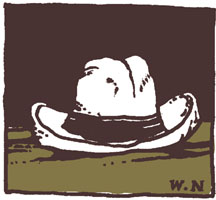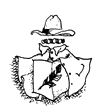 |
The
Bad Homburg
Woodcut by William Nicholson |
The Calumny of Beerbohm
Andrew Best.
In “Enoch Soames”, his memoir of a slight acquaintance with
the great poet and petit viveur of that illustrious name, Max Beerbohm
speaks with forked tongue. So seductive is his essay, that a first reading
would suggest that an infinitely superior Beerbohm was in the ascendant
and Soames in decline— or even condemned by Beerbohm to a plane
of existence so lowly that for Soames to fall any lower would be a physical
and metaphysical impossibility. But no sooner does one begin to relish
Beerbohm’s self-deprecatory tone, than it rings as false as his
pretence of sympathy for his subject. The tenor of his comment is indeed
a “pale tune irresolute,” “blown from a rotted flute.”
He salutes William Rothenstein’s swift
yet brusque acknowledgement of Soames’s presence (even though WR
called him “Edwin”), and the artist’s later generosity
in drawing his portrait; yet Beerbohm, on the few occasions when he
met Soames, felt mortified by his own meretriciousness, and Rothenstein’s
generosity served simply to rub salt into the wound. Beerbohm may well
have wished that he himself had been endowed with the same spirit as
Rothenstein, for, deep-down, he knew that, in Soames, he had encountered
something rare indeed in Decadent literary circles: sheer genius, even
though that genius inhabited the seemingly dingy soul of a plain, unvarnished
Preston man.
Beerbohm remained hypnotised by The Yellow
Book, which beckoned like a gas flare in the ’Nineties fog, and
bewitched by the glittering Henry Harland, who twinkled like a star
hovering above the Savoy; but Soames, steady as a weed-grown rock pounded
by the ocean, was the voice of Beerbohm’s uneasy conscience, and
an uncomfortable challenge to the essayist’s fragile integrity.
Beerbohm had published no fewer than eleven
prose works and volumes of caricatures by 1919, the year in which he
immortalised Enoch Soames. But during the course of a long life he was
to produce little else and—crucially—was never a poet. He
may well have been profoundly envious of the dim, lank-haired Northerner
in his outlandish waterproof cape, who could record and proclaim, not
in merely “tripping numbers”, as the Preston Telegraph commented
dutifully, but with the ring of dreadful truth:
Round and round the shutter’d Square I
stroll’d with the Devil’s arm in mine. No sound but the scrape
of his hooves was there And the ring of his laughter and mine. We had
drunk black wine.
Few mortals may have read “Nocturne”,
but its tripping numbers echoed down the caverns of Hell, and reminded
the Devil of that agreeable evening he had spent with Soames in Soho
(that “black wine” may have been from Cahors, on the fringe
of that Cathar country which had yielded him so rich a harvest of the
damned). He was flattered by Soames’s beautifully-judged poem,
and the hunger for appreciation, the longing to be liked, understandable
in so great a Potentate, was to be his downfall. He recalled that Soames
had proclaimed himself a Diabolist, failing to remember that the poet—always
a master of ambiguity—had hedged his bets by calling himself a
Catholic Diabolist. Mind you, the Prince of Darkness always deeply resented
the fact that it had been the Catholic Church who had invented him in
the first place.
Thus it was that he struck his bargain with
Soames, and it must be admitted that Soames’s request was somewhat
foolhardy: to be swept a hundred years hence, on into the Reading Room
of the British Museum of 3 June, 1997 in order to examine the plethora
of critical comment that would by that time surely surround his name
and reputation. But all Soames found was an idle critic’s reference
to Beerbohm’s essay, implying, without a shred of evidence, that
he had never existed...
While one can only hope and pray that Soames’s
reputation, indeed his very person, will be restored to the literary
canon, one can be sure of two things. The first is that Beerbohm was
an unreliable witness, jealous of Soames’s dedication to his art
and even, perhaps, of the sizeable annuity which enabled him so single-mindedly
to court his Muse. The second is that the Devil lost the bargain: his
enthusiasm for Soames’s poor soul, fuelled by Soames’s thirst
for recognition, made him careless. He gave Soames an afternoon of his
own private Hell, once-for-all; and the agonising glimpse the writer
had of that place was—as any good Diabolist should know—to
suffice for all Eternity. Once in Hell itself, Soames, in common with
countless lesser souls, remains condemned endlessly to repeat his most
selfish and unproductive desires. These were few indeed, but continually
to supply the poet with absinthe and cigarettes makes him an expensive
guest, and his host has no option but to pay up.
Beerbohm made one significant error of fact:
Soames’s voluminous cape may have been waterproof, but was, in
fact, lined with asbestos.
|



